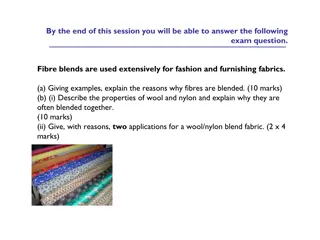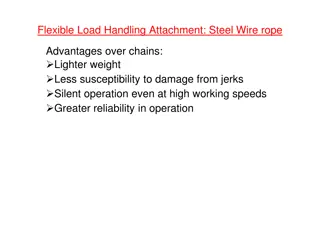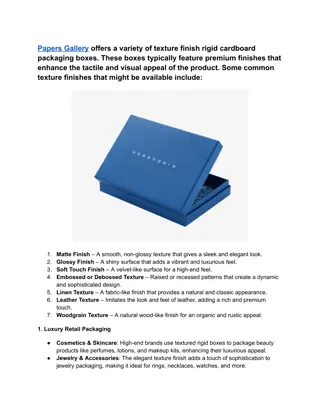Understanding Finishes for Woodturning Projects
Exploring the chemistry of finishes in woodturning, this guide covers the importance of surface preparation, different types of finishes available such as urethanes, lacquer, and shellac, as well as special techniques like friction polishing and French polish. It emphasizes the significance of selecting the right finish based on the project's intended use, especially for food-safe items.
Download Presentation

Please find below an Image/Link to download the presentation.
The content on the website is provided AS IS for your information and personal use only. It may not be sold, licensed, or shared on other websites without obtaining consent from the author. Download presentation by click this link. If you encounter any issues during the download, it is possible that the publisher has removed the file from their server.
E N D
Presentation Transcript
THIS IS STILL JUST ONE OPINION. ALTHOUGH, I DO KNOW SOMETHING ABOUT THE CHEMISTRY OF FINISHES FINISHES FINISHES EVERYTHING YOU NEED TO KNOW TO GET STARTED IN WOODTURNING
FINISHES FOR THE WOODTURNER FINISHES FOR THE WOODTURNER THE ONLY IMPORTANT QUESTION ABOUT FINISHING WOOD IS WHAT DO YOU LIKE? THIS IS TRUE FOR FLATWORK OR TURNED PROJECTS There are many choices addressing the nature of the piece, eventual use, type of wood, personal preference
FINISHES FOR THE WOODTURNER FINISHES FOR THE WOODTURNER The first step in finishing any wood project is preparing the surface to receive the top-coat (FILM) finish NO FINISH IS ANY BETTER THAN THE SURFACE TO WHICH IT IS APPLIED The surface is improved by 1)better cuts, 2)sharper tools, and 3)sanding Sanding usually goes up through 400 to 600 grit Exotic woods can easily be sanded through 2000 grit
FINISHES FOR THE WOODTURNER FINISHES FOR THE WOODTURNER FILM FINISHES The same products used in flatwork are available to the woodturner Urethanes, Lacquer, Shellac, Stains and dyes Most of you have used these finishes and the rules are not much different for lathe projects Less common in flatwork are Oil and Wax Important for food-use items
FINISHES FOR THE WOODTURNER FINISHES FOR THE WOODTURNER A major difference between flatwork and turning is that the lathe is a source of energy for drying and setting finishes as well as sanding FRICTION POLISHING allows finishes to be dried quickly- easier to build a finish on the lathe FRENCH POLISH is the flatwork analog In this case heat and speed are your friends
FINISHES FOR THE WOODTURNER FINISHES FOR THE WOODTURNER Choice of finish depends on the final use of the project, i.e., items for food use Most finishes are food safe after drying It is important to know what is in the finish Ornamental projects can be finished with almost any product Drying agents are not safe for food-use projects because they do not evaporate-they stay on the surface-in the finish layer
FINISHES FOR THE WOODTURNER FINISHES FOR THE WOODTURNER DRYING OILS LINSEED, TUNG, WALNUT, POPPY SEED, and PERILLA OIL ARE THE NATURAL DRYING OILS Exposure to oxygen (also heat and light) cause these oils high in polyunsaturated fats to chemically bond to each other. Alkyd and other resins have replaced them in paints
FINISHES FOR THE WOODTURNER FINISHES FOR THE WOODTURNER DRYING AGENTS CAUSE OILS THAT ARE NOT NATURAL DRYING OILS TO HARDEN Japan Dryer is a generic name for many drying agents. Japanese lacquer work is the oldest know use of drying agents-Urushiol Common DRYING AGENTS are usually metal ions (Lead, Cadmium, Cobalt, Arsenic, Chromium, Zirconium) but organic drying agents are also used (Naptha derivatives, Methyl Ethyl Ketone derivatives)
Applying an oil/wax friction polish Applying an oil/wax friction polish FOR FOOD-USE PIECES, I PREFER A FRICTION POLISHED OIL/WAX FINISH
FINISHES FOR THE WOODTURNER FINISHES FOR THE WOODTURNER WHAT IS NOT A GOOD WOOD FINISH? Mineral oil: A piece treated with mineral oil needs to be redressed every 30 days because it evaporates, exposing the open wood grain. Beeswax: Exposure to air causes beeswax to begin to break down, producing white particles
FINISHES FOR THE WOODTURNER FINISHES FOR THE WOODTURNER The good news is that most beeswax sold in not pure beeswax. Mixture with other waxes (about 25-30%v/v) prevents this degradation process.
FINISHES FOR THE WOODTURNER FINISHES FOR THE WOODTURNER WHAT DO YOU LIKE?























